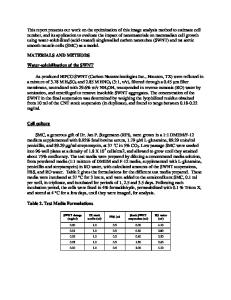Interactions of Carbon Nanomaterials With Mammalian Cells
- PDF / 227,055 Bytes
- 6 Pages / 612 x 792 pts (letter) Page_size
- 86 Downloads / 477 Views
0951-E04-08
Interactions of Carbon Nanomaterials With Mammalian Cells Pavan M. V. Raja1, Jennifer Connolley2, Lijie Ci3, Gopal P. Ganesan4, Pulickel M. Ajayan3, Omkaram Nalamasu3,4, and Deanna M. Thompson2 1 Chemical and Biological Engineering, Rensselaer Polytechnic Institute, Troy, NY, 2180 2 Biomedical Engineering, Rensselaer Polytechnic Institute, Troy, NY, 12180 3 Materials Science and Engineering, Rensselaer Polytechnic Institute, Troy, NY, 12180 4 Center for Integrated Electronics, Rensselaer Polytechnic Institute, Troy, NY, 12180
ABSTRACT Despite their diverse application potential, carbon nanotubes (CNT) have adverse effects in vitro, and in vivo. Previous research has focused on the in vitro cytotoxic impact of CNT aggregates and associated nanoparticulate impurities. In this study, we compared the singlewalled carbon nanotube (SWNT) aggregates, and their associated finely dispersed, nonaggregated carbon nanomaterials on rat aortic smooth muscle cells (SMC), through filtration of the aggregates from the CNT-treated cell culture media. In general, our research shows that the removal of single-walled carbon nanotube (SWNT) aggregates from cell culture test media inhibited the growth in SMC to a lower extent than the corresponding unfiltered media at prefiltered SWNT dosages below 0.10 mg/ml. We also found suspended nanoparticles (likely amorphous and graphitic carbon associated with the SWNT) and a small quantity of SWNT in the filtered media may have contributed to the observed cell growth inhibition by the filtered media. In addition, we compared the effect of SWNT, a nano-sized material, with activated carbon (AC), a nanoporous, microparticulate material, on SMC growth. AC (0.1 mg/ml) was found to be less inhibitory to SMC growth than the SWNT aggregates and suspended matter (at 0.1 mg/ml prefiltered dosage), potentially implying an inverse proportionality between carbon nanomaterial size regimes and cell growth inhibition. INTRODUCTION Carbon nanotubes (CNT), by virtue of their high strength, small size, potential for tunable surface chemistry, and unique electrical properties, have found a wide range of possible applications ranging from polymer composites and electronic devices [1] to vehicles for drug delivery and gene therapy [2]. However, the rapid growth of CNT-related technologies and their resultant application needs to be complemented with a detailed understanding of their impact on human health. Studying the interactions between the CNT and mammalian cells provide a simple and reliable approach, in vitro. In addition, comparing the biological impact of CNT, with those of other nanomaterials – especially carbon-based nanomaterials, could provide a relativistic estimation of the potential CNT toxicity. CNT can be broadly classified into two categories: singlewalled (SWNT) and multiwalled carbon nanotubes (MWNT), and are typically very polydisperse in nature [1]. CNT form aggregates of different shapes and sizes upon their dispersal in cell culture media, prior to their interaction with the cell
Data Loading...











